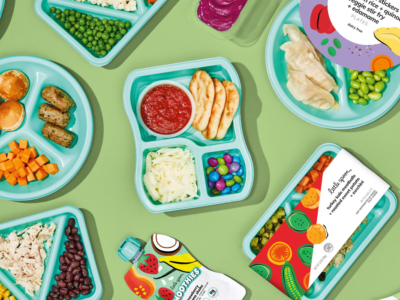By Dr. Taylor Lin, Pediatric Allergist, Immunologist & Advisor at Bébé Foodie
Once you’ve introduced your baby to a few different solid foods, it’s time to think about introducing allergens! We know, we know, this can be scary or daunting for a lot of parents. However, the latest research* shows that early introduction of allergenic foods can help prevent food allergies from developing. In fact, it even indicates that delaying the introduction of highly allergenic foods after the first year of life might increase the possibility of developing a food allergy. Here are Dr. Taylor Lin’s 6 pro tips:
*The American Academy of Pediatrics (AAP) and pediatric food allergists recommend families introduce common allergens around 6 months of age. This recommendation stems from a pivotal study called the LEAP trial1, which taught us that feeding certain infants peanut early in life and continuing to feed them peanut prevents the development of peanut allergy. After reading this summary we hope you feel informed and empowered to start feeding your baby some allergens early on! 1
1. Identify the Top Allergens
Certain proteins in food products can trigger a person’s allergic immune system to react. While any food could potentially be the cause of an allergic reaction, the good news is there are 9 food groups that contain proteins that most commonly cause food allergy symptoms in children. The 9 most common allergens are:
- Cow’s milk (dairy)
- Egg
- Wheat
- Soy
- Peanut
- Tree nuts (e.g. cashew, pistachio, walnut, pecan, almond, hazelnut)
- Sesame
- Finned fish (e.g. salmon, cod)
- Shellfish (e.g. shrimp, mussels)
It is important to note that these proteins are in all different types of foods. For example, a child allergic to cow’s milk will react to whole milk, skim milk, cow’s milk based formula, cow’s milk yogurt, ranch dressing, and cheese. Egg allergic patients will react to whole eggs, egg whites, mayonnaise, and often eggs baked into cupcakes or muffins.
2. Watch for Signs of Readiness!
Before introducing the 9 allergenic food groups, make sure your infant is showing developmental signs of readiness. The American Academy of Pediatrics (AAP) and the World Health Organization (WHO) recommend infants begin introduction of complementary foods beyond breastmilk or formula around 6 months, although some children are developmentally ready for solid foods a little before or after that. You will have to follow your baby’s cues!
Signs that your baby is ready to start foods beyond breastmilk or formula include:
- Head control – they can hold their head up on their own without support
- Sitting with little to no support
- Baby is ready to chew and is opening their mouth when presented with food
- Baby seems to want to participate during mealtimes
Your baby should try non-allergenic foods like some fruits and vegetables as their first solids, before introducing allergens.
3. Start Small and Slow
Starting with small amounts of the allergen at the start is important, just in case a reaction does occur. Try one allergen for 3-4 consecutive days in increasing amounts before trying the next. Here are some essential tips on trying the allergens:
- Pick a day when your infant is healthy and home. Make sure you are present.
- Do not give more than one new food at a time (e.g. serve peanut powder with oatmeal after they have tolerated oatmeal)
- Give your child a very small amount of the food first and watch for 5 minutes to make sure they are acting normally. I recommend starting with a small bite the size of your pinky fingernail.
- If they are not showing signs of a reaction, offer more. I recommend up to 1-2 teaspoons total.
- Stay with your infant for at least 2 hours after the feeding to watch for possible allergic reaction.
Here is a list of easy to make at home and infant-Friendly Options for Allergen Introduction:
- Peanut: peanut powder, peanut puffs mixed with water, peanut butter mixed with water/formula/breastmilk to be liquid consistency. *DO NOT give your child whole peanuts or peanut butter
- Egg: homemade pancakes with egg, scrambled egg, homemade French toast with egg
- Milk: dairy yogurt, soft pasteurized cheese, cottage cheese, cow’s milk formula
- Tree nuts: tree nut butters (introduce each tree nut individually) such as almond butter or cashew butter mixed with water/formula/breastmilk to be liquid consistency
- Sesame: hummus
- Wheat: soft pasta, infant wheat crackers, cream of wheat
- Soy: pureed soybeans, soft tofu, soy milk yogurt, soy milk mixed in oatmeal
- Fish: fully cooked, soft, deboned fish
- Shellfish: fully cooked, soft shellfish such as shrimp, crab, or lobster
4. Keep a Close Eye on Reactions
Allergic reactions are easy to spot, even in non-verbal infants. Here are some telltale signs of a reaction and what to do if it occurs. Reactions are typically rapid, repetitive, and responsive.
- RAPID – Rapid onset after ingestion of the allergen, usually within minutes, although vomiting can occur 1-4 hours later.
- REPETITIVE – A reaction occurs each time the allergen is ingested
- RESPONSIVE – Improvement or resolution of symptoms after treatment with allergy medicine
Signs of a reaction, typically occurring while eating or immediately afterwards:
- Irritable, fussy
- Appearing distressed or uncomfortable
- Develops a rash – red, can be flat or raised. Can be around the mouth, face, or spread over the whole body
- Rubbing eyes, nose, ears or scratching their skin
- Refuses more food
- Vomits
- Swelling of lips, tongue, or eyelids
- Less responsive to you, acting sleepy
- Coughing, wheezing or labored breathing
What to do:
If your child only appears mildly uncomfortable, itchy, or develops a rash, give them their appropriate weight-based dose of diphenhydramine (Benadryl) or liquid cetirizine (Zyrtec). This should improve mild reaction symptoms within 15 minutes. If your child is not improving quickly after the medication, you should take them immediately to an urgent care or emergency room for treatment. If you live more than 5-10 minutes away from care, are alone with your child, or your child is not responding to you appropriately or having difficulties breathing, you should call emergency services right away. They can treat your child while they transport you to a hospital. Although exceedingly rare in infants, allergic reactions to food can be severe and fatal if left untreated.
If your child looks well for a few hours after eating the new allergen, but then has repetitive forceful vomiting, loose stools, appears pale or gray, and is not acting normally, this can also be a sign of a food allergy type called food protein induced enterocolitis syndrome (FPIES). This usually occurs 1-4 hours after eating the food allergen. If your child is repetitively vomiting and looking sick, you should call emergency services right away as they may need IV fluids.
5. Keep Feeding the Allergen!
If your child did well with 3-4 days of eating the allergen without reaction, it is imperative you keep it in their diet on a regular basis. This means at least 3 times/week they are eating that food in some form. If the infant is not routinely eating the allergen, they can develop a food allergy over time.
6. When To Seek Professional Advice?
If your infant has had any reaction at home to a food, you should talk to your pediatrician or pediatric allergist before retrying that food at home. You should also wait to introduce new food allergens until speaking with them, as some food allergies can occur together more frequently (e.g. peanut and egg, peanuts and tree nuts). Most children do not need to have testing first, but if your infant has eczema or other food allergies, you should talk with a medical professional first to make a safe personalized plan for your baby.
Integrating common food allergens in the diet takes time and patience. Remember you have the support of your child’s healthcare providers if you have specific questions about your solid food introduction journey.
Bébé Foodie offers helpful, stress-free advice backed by experts and tailored to your family’s lifestyle. You can follow @bebefoodie_ or go to www.bebe-foodie.com to learn more.
- Du Toit G, Roberts G, Sayre PH, Bahnson HT, Radulovic S, Santos AF, et al. Randomized trial of peanut consumption in infants at risk for peanut allergy. N Engl J Med. 2015:372:803-13.
- Fleischer DM, Chan ES, Venter C, et al. A Consensus Approach to the Primary Prevention of Food Allergy Through Nutrition: Guidance from the American Academy of Allergy, Asthma, and Immunology; American College of Allergy, Asthma, and Immunology; and the Canadian Society for Allergy and Clinical Immunology. J Allergy Clin Immunol Pract. 2021; 9(1):22-43.



